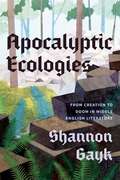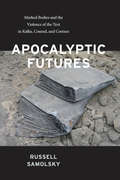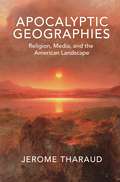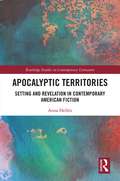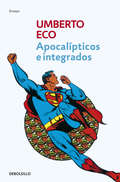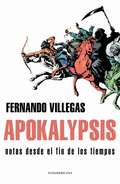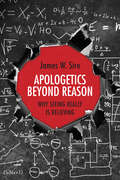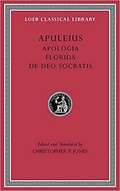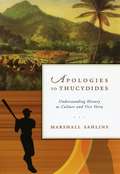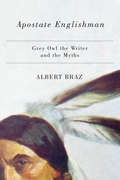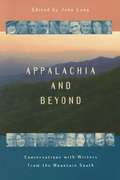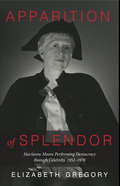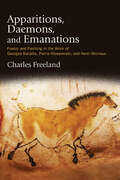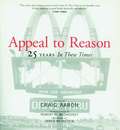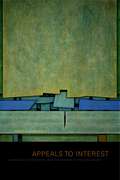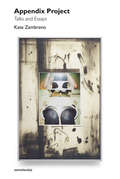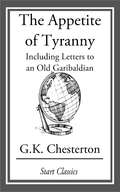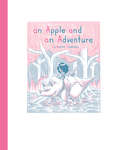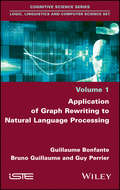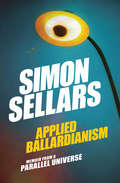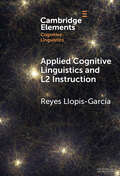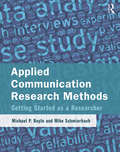- Table View
- List View
Apocalyptic Ecologies: From Creation to Doom in Middle English Literature
by Shannon GaykA meditative reflection on what medieval disaster writing can teach us about how to respond to the climate emergency. When a series of ecological disasters swept medieval England, writers turned to religious storytelling for precedents. Their depictions of biblical floods, fires, storms, droughts, and plagues reveal an unsettled relationship to the natural world, at once unchanging and bafflingly unpredictable. In Apocalyptic Ecologies, Shannon Gayk traces representations of environmental calamities through medieval plays, sermons, and poetry such as Cleanness and Piers Plowman. In premodern disaster writing, she recovers a vision of environmental flourishing that could inspire new forms of ecological care today: a truly apocalyptic sensibility capable of seeing in every ending, every emergency a new beginning waiting to emerge.
Apocalyptic Futures: Marked Bodies and the Violence of the Text in Kafka, Conrad, and Coetzee
by Russell SamolskyIn this book, the author argues that certain modern literary texts have apocalyptic futures. Rather than claim that great writers have clairvoyant powers, he examines the ways in which a text incorporates an apocalyptic event into its future reception. He is thus concerned with the way in which apocalyptic works solicit their future receptions.Apocalyptic Futures also sets out to articulate a new theory and textual practice of the relation between literary reception and embodiment. Deploying the double register of “marks” to show how a text both codes and targets mutilated bodies, the author focuses on how these bodies are incorporated into texts by Kafka, Conrad, Coetzee, and Spiegelman.Situating “In the Penal Colony” in relation to the Holocaust, Heart of Darkness to the Rwandan genocide, and Waiting for the Barbarians to the revelations of torture in apartheid South Africa and contemporary Iraq, the author argues for the ethical and political importance of reading these literary works’ “apocalyptic futures” in our own urgent and perilous situations. The book concludes with a reading of Spiegelman's Maus that offers a messianic counter-time to the law of apocalyptic incorporation.
Apocalyptic Geographies: Religion, Media, and the American Landscape
by Jerome TharaudHow nineteenth-century Protestant evangelicals used print and visual media to shape American cultureIn nineteenth-century America, "apocalypse" referred not to the end of the world but to sacred revelation, and "geography" meant both the physical landscape and its representation in printed maps, atlases, and pictures. In Apocalyptic Geographies, Jerome Tharaud explores how white Protestant evangelicals used print and visual media to present the antebellum landscape as a “sacred space” of spiritual pilgrimage, and how devotional literature influenced secular society in important and surprising ways.Reading across genres and media—including religious tracts and landscape paintings, domestic fiction and missionary memoirs, slave narratives and moving panoramas—Apocalyptic Geographies illuminates intersections of popular culture, the physical spaces of an expanding and urbanizing nation, and the spiritual narratives that ordinary Americans used to orient their lives. Placing works of literature and visual art—from Thomas Cole’s The Oxbow to Harriet Beecher Stowe’s Uncle Tom’s Cabin and Henry David Thoreau’s Walden—into new contexts, Tharaud traces the rise of evangelical media, the controversy and backlash it engendered, and the role it played in shaping American modernity.
Apocalyptic Territories: Setting and Revelation in Contemporary American Fiction (Routledge Studies in Contemporary Literature)
by Anna HellénResearch on the relationship between the apocalyptic tradition and the literary imagination has typically espoused a temporal approach which in one way or another revolves around the order of events that precedes the end of history and the ensuing establishment of a new world. This study, by contrast, explores the spatial dimensions of apocalypse, more precisely the way in which the settings of the Book of Revelation are taken up by contemporary American writers and related to more general but also more contested concerns of territorial integrity and national identity. Influenced by Lefebvre’s theories, the study understands territory not simply as the container of certain structures and practices but also as the result of them, just as bird song is not framed by but rather constructive of territorial borders. It is the equivalent of such ‘songs’ that this book seeks to listen in on, i.e. the apocalyptic narratives that have been passed on through the centuries to define and sustain territory on a local, regional, and national level, and the way in which seven novels by Rick Moody, Toni Morrison, Jesmyn Ward, Cormac McCarthy, and Michael Chabon respond to them.
Apocalípticos e integrados
by Umberto EcoUna colección de ensayos magistrales sobre la cultura de masas. En una serie de ensayos magistrales sobre la cultura de masas -en los que analiza la estructura del mal gusto, la lectura de los cómics, el mito de Superman, la canción de consumo, el papel de los medios audiovisuales como instrumento de información o el influjo de la televisión en el mundo de hoy-, Eco se plantea el problema central de la doble postura ante la cultura de masas: la de los apocalípticos, que ven en ella la «anticultura», el signo de una caída irrecuperable, y la de los integrados, que creen optimistamente que estamos viviendo una magnífica generalización del marco cultural.
Apokalypsis
by Fernando Villegas DarrouyUn análisis exhaustivo del fenómeno global, los desgarros de la sociedad chilena, los clamores de los estudiantes, las aspiraciones de los mapuches y las quejas de todos La inestabilidad parece ser lo único claro en estos tiempos movidos. Tiempos en que las crisis se multiplican, así como las manifestaciones -la primavera árabe, los indignados, el movimiento estudiantil en Chile-, en las cuales afloran el descontento, la rabia y la frustración. En estos lapsos históricos sentimos que cuatro horrorosos jinetes atropellan el mundo en calamitosa galopada sembrando el caos, la muerte y la destrucción. Entonces hablamos del «fin de los tiempos», del «acabo de mundo», del «día del juicio final». O del Apokalypsis.Fernando Villegas se hace cargo de estos conflictos e interrogantes y realiza un análisis exhaustivo del fenómeno global en el que estamos inmersos, de los desgarros de la sociedad chilena, los clamores de los estudiantes, las aspiraciones de los mapuches y las quejas de todos.
Apologetics Beyond Reason: Why Seeing Really Is Believing
by James W. Sire"Look carefully. Listen closely. Do you see? Do you hear? There are a million signposts pointing toward the specific truth of God in Christ. I've seen many of them. But God is speaking to you too. Look and see. Listen and hear." In this accessible and engaging work, veteran apologist Jim Sire gives us eyes to see the myriad "signals of transcendence" all around us that point to the specific truth of God in Christ. Focusing on the power of good literature—even from those who deny the existence of God—enables us to perceive and testify to God's reality in ways that rational argument alone cannot. "While reason can be very helpful in pointing us to God and helping us in our apologetics, what compels and convinces people is more multidimensional," says Sire. "What is needed is a more holistic apologetic that not only includes truth but also goodness and beauty." All inspiration is rooted in God the Creator, and some of God's truth lies buried until an artist exposes it. Good literature, written from a Christian standpoint or not, displays multiple examples of our human understandings of God, the universe and ourselves. It testifies to the existence of a transcendent realm and often, in fact, to the truth of the Christian faith.
Apologia. Florida. De Deo Socratis (Loeb Classical Library #534)
by Apuleius Christopher P. JonesApuleius, one of the great stylists of Latin literature, was born ca. 125 AD in Madauros to a politically prominent family and received an elite education in the provincial capital Carthage and at Athens, where he began a lifelong allegiance to Platonic philosophy. In the later 150s, he married Pudentilla of Oea, a wealthy widow, and seems to have enjoyed a distinguished public career in Africa and perhaps as an advocate in Rome. Although Apuleius is best known for his picaresque novel Metamorphoses or The Golden Ass (LCL 44, 453), he also wrote and declaimed on a wide variety of subjects. This edition contains the other surviving works of Apuleius that are considered genuine. Apologia is a speech in which Apuleius defends himself against in-laws who had accused him of having used sinister means, including magic, to induce Pudentilla to marry him. The Florida is a collection of twenty-three excerpts from speeches by Apuleius. De Deo Socratis (On Socrates’ God) locates Socrates’ invisible guide and protector (daimonion) within the more general concept of daimones as forces intermediary between gods and humans. This edition, new to the Loeb Classical Library, offers fresh translations and texts based on the best critical editions.
Apologies to Thucydides: Understanding History As Culture and Vice Versa
by Marshall SahlinsThucydides' classic work on the history of the Peloponnesian War is the root of Western conceptions of history--including the idea that Western history is the foundation of everyone else's. Here, Marshall Sahlins takes on Thucydides and the conceptions of history he wrought with a groundbreaking new book that shows what a difference an anthropological concept of culture can make to the writing of history. Sahlins begins by confronting Thucydides' account of the Peloponnesian War with an analogous "Polynesian War," the fight for the domination of the Fiji Islands (1843-55) between a great sea power (like Athens) and a great land power (like Sparta). Sahlins draws parallels between the conflicts with an eye to their respective systems of power and sovereignty as well as to Thucydides' alternation between individual (Pericles, Themistocles) and collective (the Athenians, the Spartans) actors in the making of history. Characteristic of most histories ever written, this alternation between the agency of "Great Men" and collective entities leads Sahlins to a series of incisive analyses ranging in subject matter from Bobby Thomson's "shot heard round the world" for the 1951 Giants to the history-making of Napoleon and certain divine kings to the brouhaha over Elián Gonzalez. Finally, again departing from Thucydides, Sahlins considers the relationship between cultural order and historical contingency through the recounting of a certain royal assassination that changed the course of Fijian history, a story of fratricide and war worthy of Shakespeare. In this most convincing presentation yet of his influential theory of culture, Sahlins experiments with techniques for mixing rich narrative with cultural explication in the hope of doing justice at once to the actions of persons and the customs of people. And he demonstrates the necessity of taking culture into account in the creation of history--with apologies to Thucydides, who too often did not.
Apostate Englishman: Grey Owl the Writer and the Myths
by Albert BrazIn the 1930s Grey Owl was considered the foremost conservationist and nature writer in the world. He owed his fame largely to his four internationally bestselling books, which he supported with a series of extremely popular illustrated lectures across North America and Great Britain. His reputation was transformed radically, however, after he died in April 1938, and it was revealed that he was not of mixed Scottish-Apache ancestry, as he had often claimed, but in fact an Englishman named Archie Belaney. Born into a privileged family in the dominant culture of his time, what compelled him to flee to a far less powerful one? Albert Braz’s Apostate Englishman: Grey Owl the Writer and the Myths is the first comprehensive study of Grey Owl’s cultural and political image in light of his own writings. While the denunciations of Grey Owl after his death are often interpreted as a rejection of his appropriation of another culture, Braz argues that what troubled many people was not only that Grey Owl deceived them about his identity, but also that he had forsaken European culture for the North American Indigenous way of life. That is, he committed cultural apostasy.
Appalachia and Beyond: Conversations with Writers From the Mountain South
by John LangThe last quarter-century has seen a remarkable outpouring of fiction and poetry from southern Appalachia--a surge of creativity that has formed an integral part of a larger, and still growing, regional self-consciousness. This book charts the course of this literary renaissance through twenty-one interviews with contemporary Appalachian writers, conversations conducted between 1983 and 2003 at Emory & Henry College's annual literary festival and originally printed in the Iron Mountain Review. The authors interviewed range from nationally known figures such as Fred Chappell, Robert Morgan, Lee Smith, Mary Lee Settle, and Charles Wright to less prominent, though no less gifted, writers like George Ella Lyon, Jo Carson, and George Scarborough. Many of the interviewers are themselves creative writers or Appalachian studies scholars, as well as longtime friends of the interviewees. For example, Jim Wayne Miller interviews James Still; Loyal Jones interviews Jim Wayne Miller; Richard Marius interviews Wilma Dykeman; George Garrett interviews David Huddle; and Michael Chitwood interviews Michael McFee. These wide-ranging conversations address such topics as formative experiences in the author's childhood, major literary influences, the author's educational background and mentors, the writing process, the limitations imposed by such labels as "Appalachian writer," and the broadening scope of literature originating in the Appalachian region. Collectively, these interviews confirm the judgment of some observers that writers from the mountain South are now playing a much larger role in southern letters than in previous periods, thus constituting a "renaissance within a renaissance."
Apparition of Splendor: Marianne Moore Performing Democracy through Celebrity, 1952–1970
by Elizabeth GregoryWhile the later work of the great Modernist poet Marianne Moore was hugely popular during her final two decades, since her death critics have condemned it as trivial. This book challenges that assessment: with fresh readings of many of the late poems and of the iconic, cross-dressing public persona Moore developed to deliver them, Apparition of Splendor demonstrates that Moore used her late-life celebrity to activate egalitarian principles that had long animated her poetry, in daring and innovative ways. Dressed as George Washington in cape and tricorn and writing about accessible topics, she reached a wide cross-section of Americans, engaging them in consideration of what democracy means in their daily lives, around issues of gender, sexuality, racial integration, class, age, immigration, and species-ism. Her work resonates with that of her younger contemporaries, including poets like John Ashbery, Frank O’Hara, and Elizabeth Bishop, and artists like Andy Warhol, Yoko Ono, and Ray Johnson. Published by the University of Delaware Press. Distributed worldwide by Rutgers University Press.
Apparitions, Daemons, and Emanations: Poetry and Painting in the Work of Georges Bataille, Pierre Klossowski, and Henri Michaux (SUNY series, Intersections: Philosophy and Critical Theory)
by Charles FreelandThis book presents a new study of the visual arts and poetry in the work of three well-known French writers and artists from the mid-twentieth century—Georges Bataille, Pierre Klossowski, and Henri Michaux. Each was fiercely independent, belonging to no school, academy, or political persuasion. What do they have in common? While the book's three central essays do not initially set out to establish comparisons between these writers, common ground emerges: a shared combat against culture, a shared non-representational artistic practice. Their writing, poetry, and painting offer not a portrayal of things or ideas but rather an emanation or apparition of the unknown and the infinite, one charged with deepening art's relation to life.
Apparitions: 21 Stories of Ghosts, Spirits, and Mysterious Manifestations (Critical Reading Series)
by Henry Billings Melissa Billings John F. Warner Margaret B. WarnerThis best-selling series motivates students with high-interest selections at a higher readability level. Critical Reading, a perennial favorite for middle school and high school students of all ability levels, fascinates with astounding and intriguing stories of real-life adventure. Comprehension questions reinforce literal understanding, while critical thinking questions encourage students to consider the author's purpose, make inferences, identify cause and effect, and make predictions. The entire series is designed to reinforce state reading standards. The selections in the Critical Reading series are at the highest level of readability in our triple-threat offering which also includes The Real Deal and The Wild Side. Reading Level 6-8. Interest Level 6-12
Appeal to Reason: 25 Years In These Times
by James Weinstein Craig Aaron Robert W. McChesney<P>In These Times, the national, biweekly magazine of news and opinion, has provided groundbreaking coverage of the labor movement, the environment, feminism, grassroots politics, minority communities, and the media for twenty-five years. Filled with new writing commissioned specially for this anniversary volume, images, and text highlights of the last quarter-century in the magazine, Appeal to Reason: The First 25 Years of In These Times showcases contributors to the magazine like Noam Chomsky, David Brower, and Alice Walker, to name just a few. <P>But it also asks an important question: Where do we go from here? For answers, Appeal to Reason turns to more than twenty leading progressive writers—including Barbara Ehrenreich, Juan Gonzalez, Salim Muwakkil, and Robert W. McChesney—who take a fresh look at the lessons of the past and suggest directions for the future. Exploring issues ranging from globalization and criminal justice to the environment and culture, Appeal to Reason lays a political and intellectual foundation for the debates, discussions, and movements of the next twenty-five years.
Appeals to Interest: Language, Contestation, and the Shaping of Political Agency
by Dean MathiowetzIt has become a commonplace assumption in modern political debate that white and rural working- and middle-class citizens in the United States who have been rallied by Republicans in the “culture wars” to vote Republican have been voting “against their interests.” But what, exactly, are these “interests” that these voters are supposed to have been voting against? It reveals a lot about the role of the notion of interest in political debate today to realize that these “interests” are taken for granted to be the narrowly self-regarding, primarily economic “interests” of the individual. Exposing and contesting this view of interests, Dean Mathiowetz finds in the language of interest an already potent critique of neoliberal political, theoretical, and methodological imperatives—and shows how such a critique has long been active in the term’s rich history. Through an innovative historical investigation of the language of interest, Mathiowetz shows that appeals to interest are always politically contestable claims about “who” somebody is—and a provocation to action on behalf of that “who.” Appeals to Interest exposes the theoretical and political costs of our widespread denial of this crucial role of interest-talk in the constitution of political identity, in political theory and social science alike.
Appeals to Interest: Language, Contestation, and the Shaping of Political Agency
by Dean MathiowetzIt has become a commonplace assumption in modern political debate that white and rural working- and middle-class citizens in the United States who have been rallied by Republicans in the “culture wars” to vote Republican have been voting “against their interests.” But what, exactly, are these “interests” that these voters are supposed to have been voting against? It reveals a lot about the role of the notion of interest in political debate today to realize that these “interests” are taken for granted to be the narrowly self-regarding, primarily economic “interests” of the individual. Exposing and contesting this view of interests, Dean Mathiowetz finds in the language of interest an already potent critique of neoliberal political, theoretical, and methodological imperatives—and shows how such a critique has long been active in the term’s rich history. Through an innovative historical investigation of the language of interest, Mathiowetz shows that appeals to interest are always politically contestable claims about “who” somebody is—and a provocation to action on behalf of that “who.” Appeals to Interest exposes the theoretical and political costs of our widespread denial of this crucial role of interest-talk in the constitution of political identity, in political theory and social science alike.
Appendix Project: Talks and Essays (Semiotext(e) / Native Agents)
by Kate ZambrenoOn the ongoing project of writing about grief; Zambreno's addendum to Book of Mutter.“I came up with the idea of writing these notes, or talks, out of a primary desire to not read from Book of Mutter, and instead to keep gesturing to its incompleteness and ongoingness, which connects, for me, to the fragmentary project of literature, and what I long for in writing."—from Appendix ProjectInspired by the lectures of Roland Barthes, Anne Carson, and Jorge Luis Borges, Kate Zambreno's Appendix Project collects eleven talks and essays written in the course of the year following the publication of Book of Mutter, Zambreno's book on her mother that took her over a decade to write. These surprising and moving performances, underscored by the sleeplessness of the first year of her child's life, contain Zambreno's most original and dazzling thinking and writing to date. In Appendix Project Zambreno thinks through the work of On Kawara, Roland Barthes, W.G. Sebald, Bhanu Kapil, Walter Benjamin, Theresa Hak Kyung Cha, Marguerite Duras, Marlene Dumas, Louise Bourgeois, Doris Salcedo, Jenny Holzer, and more.
Appetite of Tyranny: Including Letters to an Old Garibaldian
by G. K. ChestertonBorn in London, Chesterton was educated at St. Paul's, but never went to college. He went to art school. In 1900, he was asked to contribute a few magazine articles on art criticism, and went on to become one of the most prolific writers of all time. He wrote a hundred books, contributions to 200 more, hundreds of poems, including the epic Ballad of the White Horse, five plays, five novels, and some two hundred short stories, including a popular series featuring the priest-detective, Father Brown. In spite of his literary accomplishments, he considered himself primarily a journalist. He wrote over 4000 newspaper essays, including 30 years worth of weekly columns for the Illustrated London News, and 13 years of weekly columns for the Daily News. He also edited his own newspaper, G.K.'s Weekly. (To put it into perspective, four thousand essays is the equivalent of writing an essay a day, every day, for 11 years. If you're not impressed, try it some time. But they have to be good essays, all of them, as funny as they are serious, and as readable and rewarding a century after you've written them.) Chesterton was equally at ease with literary and social criticism, history, politics, economics, philosophy, and theology. His style is unmistakable, always marked by humility, consistency, paradox, wit, and wonder. His writing remains as timely and as timeless today as when it first appeared, even though much of it was published in throw away paper. This man who composed such profound and perfect lines as "The Christian ideal has not been tried and found wanting; it has been found difficult and left untried," stood 6'4" and weighed about 300 pounds, usually had a cigar in his mouth, and walked around wearing a cape and a crumpled hat, tiny glasses pinched to the end of his nose, swordstick in hand, laughter blowing through his moustache. And usually had no idea where or when his next appointment was. He did much of his writing in train stations, since he usually missed the train he was supposed to catch. In one famous anecdote, he wired his wife, saying, "Am at Market Harborough. Where ought I to be?" His faithful wife, Frances, attended to all the details of his life, since he continually proved he had no way of doing it himself. She was later assisted by a secretary, Dorothy Collins, who became the couple's surrogate daughter, and went on to become the writer's literary executrix, continuing to make his work available after his death. This absent-minded, overgrown elf of a man, who laughed at his own jokes and amused children at birthday parties by catching buns in his mouth, was the man who wrote a book called The Everlasting Man, which led a young atheist named C.S. Lewis to become a Christian. This was the man who wrote a novel called The Napoleon of Notting Hill, which inspired Michael Collins to lead a movement for Irish Independence. This was the man who wrote an essay in the Illustrated London News that inspired Mahatma Gandhi to lead a movement to end British colonial rule in India. This was a man who, when commissioned to write a book on St. Thomas Aquinas (aptly titled Saint Thomas Aquinas), had his secretary check out a stack of books on St.
Apple and an Adventure
by Martin CendredaA young cave girl and her triceratops set out on an adventure from A to Z and make new friends along the way—galloping goliaths, nine newts, petite plesiosaurs, and more greet them on their journey through the alphabet! Martin Cendreda’s An Apple and An Adventure uses rhyme and the ABCs to create an engaging world of wonder that’s both educational and fun.
Application of Graph Rewriting to Natural Language Processing
by Guillaume Bonfante Bruno Guillaume Guy PerrierThe paradigm of Graph Rewriting is used very little in the field of Natural Language Processing. But graphs are a natural way of representing the deep syntax and the semantics of natural languages. Deep syntax is an abstraction of syntactic dependencies towards semantics in the form of graphs and there is a compact way of representing the semantics in an underspecified logical framework also with graphs. Then, Graph Rewriting reconciles efficiency with linguistic readability for producing representations at some linguistic level by transformation of a neighbor level: from raw text to surface syntax, from surface syntax to deep syntax, from deep syntax to underspecified logical semantics and conversely.
Applied Ballardianism: Memoir from a Parallel Universe (Urbanomic / K-Pulp #1)
by Simon SellarsAn existential odyssey weaving together lived experience and theoretical insight, this startling autobiographical hyperfiction surveys and dissects a world where everything connects and global technological delirium is the norm.The mediascapes of late capitalism reconfigure erotic responses and trigger primal aggression; under constant surveillance, we occupy simulations of ourselves, private estates on a hyperconnected globe; fictions reprogram reality, memories are rewritten by the future…Fleeing the excesses of 1990s cyberculture, a young researcher sets out to systematically analyse the obsessively reiterated themes of a writer who prophesied the disorienting future we now inhabit. The story of his failure is as disturbingly psychotropic as those of his magus—J.G. Ballard, prophet of the post-postmodern, voluptuary of the car crash, surgeon of the pathological virtualities pulsing beneath the surface of reality.Plagued by obsessive fears, defeated by the tedium of academia, yet still certain that everything connects to Ballard, his academic thesis collapses into a series of delirious travelogues, deranged speculations and tormented meditations on time, memory, and loss. Abandoning literary interpretation and renouncing all scholarly distance, he finally accepts the deep assignment that has run throughout his entire life, and embarks on a rogue fieldwork project: Applied Ballardianism, a new discipline and a new ideal for living. Only the darkest impulses, the most morbid obsessions, and the most apocalyptic paranoia can uncover the technological mutations of inner space.An existential odyssey inextricably weaving together lived experience and theoretical insight, this startling autobiographical hyperfiction surveys and dissects a world where everything connects and global technological delirium is the norm—a world become unmistakably Ballardian.
Applied Cognitive Linguistics and L2 Instruction (Elements in Cognitive Linguistics)
by Reyes Llopis-GarcíaBoth applied cognitive linguistics (ACL) researchers and linguists, and language instructors and professionals looking for a comprehensive and innovative access to ACL from the direct point of view of applied L2 Pedagogy, will find this Element to be of interest. There is great demand for quality teaching materials, a need for guidance on how to design them and which technology tools are of value. This Element takes a theoretical approach to that design while offering direct examples and tips for practitioners and researchers. Questions about empirical studies are explored, probing prominent empirical research, and the author provides promising evidence to support their recommendations on assetment-task design for future research. Linguists, researchers, linguistics students, graduate academic programs, and teachers of L2 languages alike will find value in this Element.
Applied Communication Research Methods: Getting Started as a Researcher
by Michael Boyle Mike SchmierbachApplied Communication Research Methods: Getting Started as a Researcher demonstrates how to apply concepts to research problems, issues, projects, and questions that communication practitioners face every day. Recognizing that students engage more directly with research methods when they experience research through hands-on practice, authors Michael Boyle and Mike Schmierbach developed this text to demonstrate the relevance of research in professional roles and communication careers. Along with its distinctive approach to research methods instruction, this text also serves as an enhanced glossary and a superior reference. Students can easily navigate key concepts and terminology, which are linked to practical exercises within the context of the instruction. In-unit activities and features provide numerous opportunities to delve further into topics covered in class, including: Research in Depth – examples of a concept being used in scholarly research Reflect and React – thought-provoking problems and issues that promote reflection and discussion Voices from Industry – Q&As with professionals working in communication industries End-of-unit activities – exercises that reinforce concepts and content Online resources, including sample syllabi, test banks, and more, are available on the companion website: www.routledge.com/cw/boyle.Applied Communication Research Methods is a concise, engaging work that today’s students and industry practitioners will embrace and keep on-hand throughout their careers.
